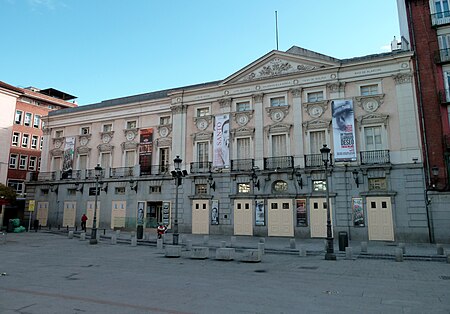Teatro Español (Madrid)

Teatro Español ("Español Theatre" – former Teatro del Príncipe and Corral del Príncipe) is a public theater administered by the Government of Madrid, Spain. The prime location was an open-air theater in medieval times where small venues and some theatrical pieces, which formed famous classical literature in later years, were staged. Its establishment was authorized by a decree of Philip II in 1565.The 18th century also marked the definitive consecration of Teatro del Príncipe, which had its own group of followers, the "chorizos," in constant struggle with the "polacos," who preferred the scenarios of the rival Teatro de la Cruz. By this time, Leandro Fernández de Moratín premiered La comedia nueva at Teatro del Príncipe. On 11 July 1802, the theater was engulfed by fire, to be re-opened five years later with the conclusion of the renovation work led by Juan de Villanueva.The current building, erected in Neoclassical style according to a design of Román Guerrero, was built between 1887 and 1895 under the direction of Natalio Grueso. In the foreground of the theater is Plaza de Santa Ana, built after the demolition of a 16th-century Carmelite monastery. The names of famous theater personalities are engraved on the façade, among them the name of Federico García Lorca.
Excerpt from the Wikipedia article Teatro Español (Madrid) (License: CC BY-SA 3.0, Authors, Images).Teatro Español (Madrid)
Calle de Manuel Fernández y González, Madrid
Geographical coordinates (GPS) Address Nearby Places Show on map
Geographical coordinates (GPS)
| Latitude | Longitude |
|---|---|
| N 40.414916666667 ° | E -3.6999 ° |
Address
College night
Calle de Manuel Fernández y González
28014 Madrid (Centro)
Community of Madrid, Spain
Open on Google Maps










